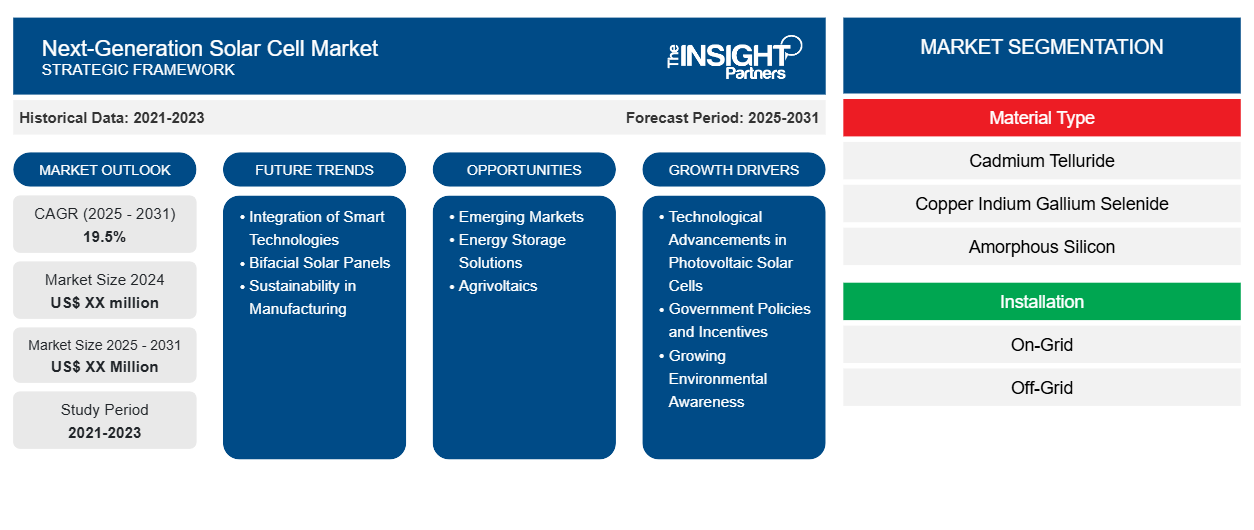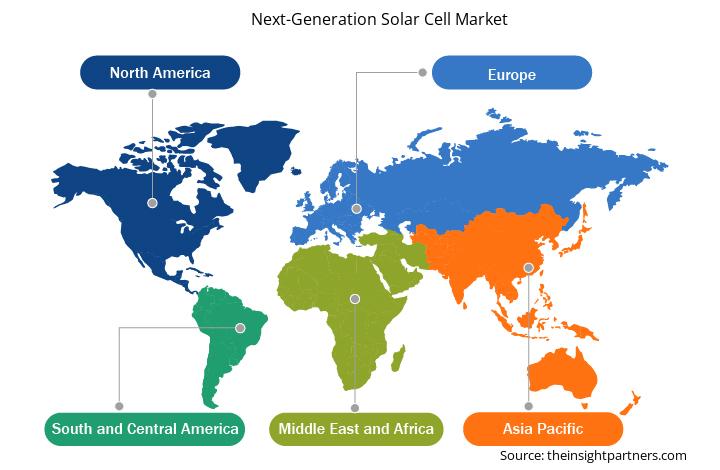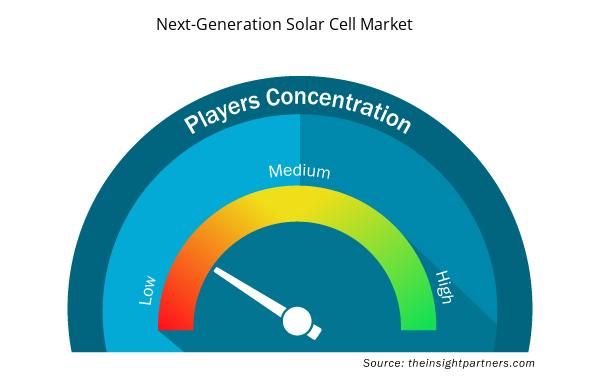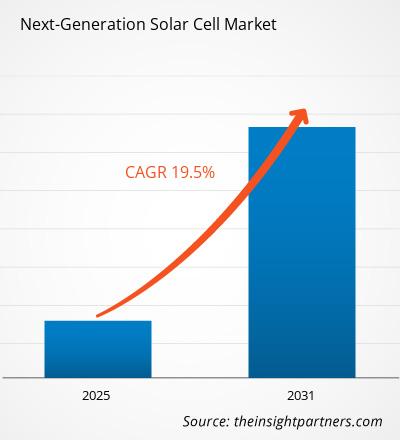The Next-Generation Solar Cell Market is expected to register a CAGR of 19.5% from 2025 to 2031, with a market size expanding from US$ XX million in 2024 to US$ XX Million by 2031.
The report is by Material Type (Cadmium Telluride (CdTe), Copper Indium Gallium Selenide (CIGS), Amorphous Silicon, Gallium-Arsenide, Others), Installation (On-Grid, Off-Grid), End-User (Residential, Commercial, Industrial, and Utilities).
Purpose of the Report
The report Next-Generation Solar Cell Market by The Insight Partners aims to describe the present landscape and future growth, top driving factors, challenges, and opportunities. This will provide insights to various business stakeholders, such as:
- Technology Providers/Manufacturers: To understand the evolving market dynamics and know the potential growth opportunities, enabling them to make informed strategic decisions.
- Investors: To conduct a comprehensive trend analysis regarding the market growth rate, market financial projections, and opportunities that exist across the value chain.
- Regulatory bodies: To regulate policies and police activities in the market with the aim of minimizing abuse, preserving investor trust and confidence, and upholding the integrity and stability of the market.
Next-Generation Solar Cell Market Segmentation
Material Type
- Cadmium Telluride
- Copper Indium Gallium Selenide
- Amorphous Silicon
- Gallium-Arsenide
Installation
- On-Grid
- Off-Grid
End-User
- Residential
- Commercial
- Industrial
- Utilities
Geography
- North America
- Europe
- Asia Pacific
- Middle East and Africa
- South and Central America
Customize This Report To Suit Your Requirement
You will get customization on any report - free of charge - including parts of this report, or country-level analysis, Excel Data pack, as well as avail great offers and discounts for start-ups & universities
Next-Generation Solar Cell Market: Strategic Insights

- Get Top Key Market Trends of this report.This FREE sample will include data analysis, ranging from market trends to estimates and forecasts.
Next-Generation Solar Cell Market Growth Drivers
- Technological Advancements in Photovoltaic Solar Cells: The next-generation solar cell market is significantly driven by ongoing innovations in photovoltaic technologies. Breakthroughs in materials science, such as the development of perovskite solar cells, are enhancing efficiency rates and reducing production costs. These advancements enable solar cells to capture a broader spectrum of sunlight, thus increasing energy output and making solar energy more competitive against traditional energy sources.
- Government Policies and Incentives: Many governments worldwide are implementing favorable policies and incentives to promote renewable energy adoption. This includes tax credits, subsidies, and renewable energy mandates that encourage the deployment of solar technologies. Such initiatives not only reduce the financial burden on consumers but also stimulate investments in solar infrastructure, thus propelling the next-generation solar cell market forward.
- Growing Environmental Awareness: As global awareness regarding climate change and environmental sustainability increases, there is a rising demand for clean energy solutions. Consumers and businesses alike are seeking to reduce their carbon footprints, driving the shift towards renewable energy sources. This cultural shift is pushing manufacturers and researchers to innovate in solar technologies, creating a robust market for next-generation solar cells.
Next-Generation Solar Cell Market Future Trends
- Integration of Smart Technologies: The incorporation of smart technologies, such as IoT and artificial intelligence, into solar energy systems is becoming a prominent trend. Smart solar panels can optimize energy production by adjusting their angles based on sunlight exposure and monitor performance in real-time. This integration enhances the efficiency and reliability of solar energy systems, making them more appealing to consumers and businesses.
- Bifacial Solar Panels: Bifacial solar panels are gaining traction due to their ability to capture sunlight from both sides, significantly increasing their energy generation potential. This trend is particularly advantageous in areas with reflective surfaces, such as snow or sand. As the technology becomes more mainstream, manufacturers are investing in designing bifacial modules to improve efficiency and cater to a growing market.
- Sustainability in Manufacturing: There is a notable shift towards sustainable manufacturing processes in the solar cell industry. Companies are increasingly focusing on reducing waste, recycling materials, and using environmentally friendly production techniques. This trend not only appeals to environmentally conscious consumers but also helps companies comply with stricter regulations and enhance their brand image in a competitive market.
Next-Generation Solar Cell Market Opportunities
- Emerging Markets: Developing countries present significant opportunities for next-generation solar cells as they seek affordable and reliable energy solutions. Many of these regions have abundant sunlight but lack access to conventional energy infrastructure. Providing solar energy solutions can help bridge the energy gap, and companies that invest in these markets can benefit from first-mover advantages and contribute to sustainable development.
- Energy Storage Solutions: The integration of energy storage technologies with solar systems offers a lucrative opportunity for the next-generation solar cell market. As the demand for reliable and consistent energy sources grows, pairing solar panels with advanced battery systems can provide consumers with the ability to store excess energy for use during non-sunny periods. This combination enhances the viability of solar energy and opens new avenues for product offerings.
- Agrivoltaics: The concept of agrivoltaics, where solar panels are installed on agricultural land, presents a unique opportunity to maximize land use. This innovative approach allows for simultaneous agricultural production and solar energy generation, providing farmers with additional income streams while promoting sustainable land use. As interest in food security and renewable energy rises, agrivoltaics could become a significant growth area for the next-generation solar cell market.
Next-Generation Solar Cell Market Regional Insights
The regional trends and factors influencing the Next-Generation Solar Cell Market throughout the forecast period have been thoroughly explained by the analysts at Insight Partners. This section also discusses Next-Generation Solar Cell Market segments and geography across North America, Europe, Asia Pacific, Middle East and Africa, and South and Central America.

- Get the Regional Specific Data for Next-Generation Solar Cell Market
Next-Generation Solar Cell Market Report Scope
| Report Attribute | Details |
|---|---|
| Market size in 2024 | US$ XX million |
| Market Size by 2031 | US$ XX Million |
| Global CAGR (2025 - 2031) | 19.5% |
| Historical Data | 2021-2023 |
| Forecast period | 2025-2031 |
| Segments Covered |
By Material Type
|
| Regions and Countries Covered | North America
|
| Market leaders and key company profiles |
Next-Generation Solar Cell Market Players Density: Understanding Its Impact on Business Dynamics
The Next-Generation Solar Cell Market market is growing rapidly, driven by increasing end-user demand due to factors such as evolving consumer preferences, technological advancements, and greater awareness of the product's benefits. As demand rises, businesses are expanding their offerings, innovating to meet consumer needs, and capitalizing on emerging trends, which further fuels market growth.
Market players density refers to the distribution of firms or companies operating within a particular market or industry. It indicates how many competitors (market players) are present in a given market space relative to its size or total market value.
Major Companies operating in the Next-Generation Solar Cell Market are:
- Hanwha Q CELLS
- Oxford PV
- Kaneka Solar Energy
- Flisom
- Mitsubishi Chemical Group
- Hanergy thin film power group
Disclaimer: The companies listed above are not ranked in any particular order.

- Get the Next-Generation Solar Cell Market top key players overview
Key Selling Points
- Comprehensive Coverage: The report comprehensively covers the analysis of products, services, types, and end users of the Next-Generation Solar Cell Market, providing a holistic landscape.
- Expert Analysis: The report is compiled based on the in-depth understanding of industry experts and analysts.
- Up-to-date Information: The report assures business relevance due to its coverage of recent information and data trends.
- Customization Options: This report can be customized to cater to specific client requirements and suit the business strategies aptly.
The research report on the Next-Generation Solar Cell Market can, therefore, help spearhead the trail of decoding and understanding the industry scenario and growth prospects. Although there can be a few valid concerns, the overall benefits of this report tend to outweigh the disadvantages.
- Historical Analysis (2 Years), Base Year, Forecast (7 Years) with CAGR
- PEST and SWOT Analysis
- Market Size Value / Volume - Global, Regional, Country
- Industry and Competitive Landscape
- Excel Dataset



Report Coverage
Revenue forecast, Company Analysis, Industry landscape, Growth factors, and Trends

Segment Covered
This text is related
to segments covered.

Regional Scope
North America, Europe, Asia Pacific, Middle East & Africa, South & Central America

Country Scope
This text is related
to country scope.
Frequently Asked Questions
The report can be delivered in PDF/PPT format; we can also share excel dataset based on the request.
The major players in the market includes Hanwha Q CELLS, Oxford PV, Kaneka Solar Energy, Flisom, Mitsubishi Chemical Group,Hanergy thin film power group, Heliatek, 3D-Micromac, Suntech Power Holdings, Sharp Corporation, Trina Solar, Panasonic Corporation, Sol Voltaics, Geo Green Power, Jinko Solar, Canadian Solar, Yingli Solar, REC Group
The incorporation of smart technologies, such as IoT and artificial intelligence, into solar energy systems is becoming a prominent trend. Smart solar panels can optimize energy production by adjusting their angles based on sunlight exposure and monitor performance in real-time.
The next-generation solar cell market is significantly driven by ongoing innovations in photovoltaic technologies. Breakthroughs in materials science, such as the development of perovskite solar cells, are enhancing efficiency rates and reducing production costs.
The global next-generation solar cell market is expected to grow at a CAGR of 19.5% during the forecast period 2024 - 2031.

 Get Free Sample For
Get Free Sample For